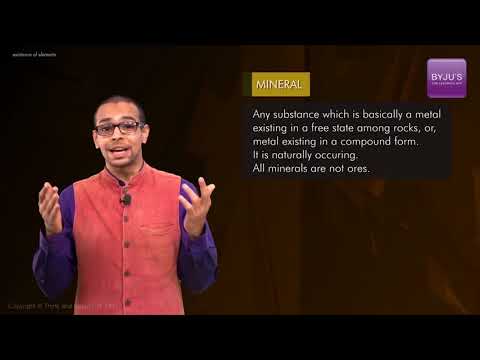Minerals are naturally occurring inorganic substances found under varying conditions and in different types of geological environments. They have a crystalline structure and come with a definite chemical composition. Minerals are divided into two types, namely metallic and non-metallic minerals.
What are Non-metallic Minerals?
Non-metals are minerals (Non-metallic minerals) which, as a rule, do not serve as raw material for the extraction of metal. The group of non-metals, which is widespread amongst the variety of minerals, is of great economic significance.
Table of Contents
- What are Metallic Minerals?
- Key Difference between Metallic and Non-metallic Minerals
- Recommended Videos
- Frequently Asked Questions – FAQs
What are Metallic Minerals?
Metallic Minerals are composed of one or more metallic elements whereas non-metallic minerals do not contain any metal elements instead they consist of chemical elements that usually don’t feature the properties or characteristics of metals.
Key Difference between Metallic and Non-metallic Minerals
When we talk about the difference between metallic and non-metallic minerals one that sticks out, in particular, is that metallic minerals are usually obtained from ores while non-metallic minerals are procured from industrial rocks and minerals. However, we will look at some of the other key differences between metallic and non-metallic minerals below.
| Difference between Metallic and Non-metallic Minerals | |
| Metallic | Non-Metallic |
| Metallic Minerals are minerals in which metal elements are present in their raw form. | Non-metallic minerals do not contain any metal substances in them. |
| When metallic minerals are melted a new product is formed. | In the case of non-metallic minerals, you don’t get any new product after such a process. |
| Metallic minerals are usually found in igneous and metamorphic rock formations. | Non-metallic minerals are often found embedded in young fold mountains and sedimentary rocks. |
| Metallic minerals are good conductors of electricity as well as heat. | Non-metallic minerals are basically good insulators of electricity and heat. |
| Metallic minerals have high malleability and ductility. | Non-metallic minerals, lack malleability and ductility and these minerals break down easily. |
| Metallic minerals generally have lustre. | Non-metallic minerals do not have any shine or lustre. |
These are some of the differences between metallic and non-metallic minerals. To know more about important differences between similar products and other chemistry topics you can keep visiting BYJU’s or download our app for interesting content and learning experience.
Recommended Videos

Frequently Asked Questions – FAQs
What are metallic minerals?
Metallic minerals, as the name suggests, are minerals containing one or more metals. These usually occur as mineral deposits and are a great heat and electricity conductor, such as iron, copper, silver, bauxite, manganese, etc.
What are nonmetallic minerals?
Non-metallic mineral reserves consist of quarries of stone and clay and sand pits; mineral deposits with chemical and fertilizer; salt deposits; quartz deposits, gypsum, natural gemstones, asphalt and bitumen, peat and other non-metallic minerals other than coal and oil.
What are metallic minerals give example?
Iron, copper, gold, silver, etc. are some common metal minerals. In their inorganic chemical formula, non-metallic minerals do not contain metal elements. Clay, Diamond, Dolomite, Gypsum, Mica, Amethyst, Quartz, etc. are some common examples.
What are metallic elements?
The metallic elements (or short metals) are the elements that have the following characteristics: they conduct electricity and heat. They are ductile and malevolent (i.e. can be deformed without breaking) and are usually solid at room temperature (the exception being mercury).
What is the most metallic element?
Francium is the most metallic component. Yet, except for one isotope, francium is a man-made element, and all isotopes are so radioactive that they almost immediately decay into another. The natural element with the highest metallic character is caesium, located on the periodic table immediately above the francium.
Related Links:
| Types of Minerals | Uses of Minerals |
| Ores And Minerals | Extraction of Metals: Ores and Minerals |

Very nice 👌 and awesome explanation
With is very important and useful. Superb explanation